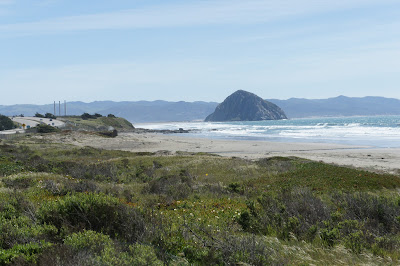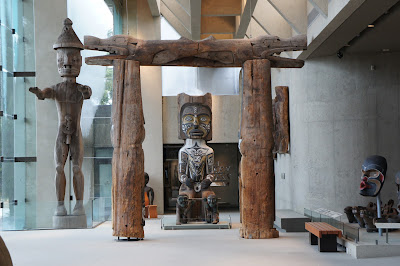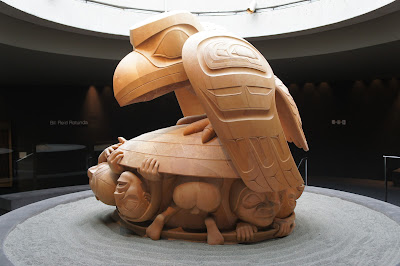Annie and I just got back from a trip to California to see family and friends. Driving the 1300 miles south on Interstate 5 can be one of the more boring experiences of a lifetime. I choose to make it interesting by keeping a running bird census: numbers and locations and dates of sightings. One item of interest was the Turkey Vultures of the inland valleys (Willamette V. of Oregon; San Joaquin V. of California). They are massing for their northerly migration. Mount Shasta, CA and Medford OR seem to be gathering points for their push north. We should see them in Bellingham by late spring.
On the trip north, we stuck to the California coast. The central coast of California is not only scenic, but has an amazing diversity of marine, shore, chaparral, and forest life. At Avila Bay, near San Luis Obispo, we saw Brown Pelicans and Sea Lions. This Brown Pelican came in for a landing at the Avila pier and chose a maintenance yard for its sun bath.
In the 1960s and early 1970s, the Brown Pelican almost became extinct, due to DDT poisoning. The long-lasting pesticide acted on the ability of pelicans to make eggs with durable shells. The eggs would crack upon laying. DDT was used in agriculture, but washed into the ocean and passed up through the food chain, becoming more concentrated at each trophic level. Brown Pelicans are fish eaters and got a significant dose of the poison. The banning of DDT saved the species.
Brown Pelican
A Remarkabl Bird, Catching Some California Sun
A Remarkabl Bird, Catching Some California Sun
I could hear loud barking going on under the pier, at the boat landing level. Going downstairs, I saw several Sea Lions lounging and sleeping. There was a sign warning people that Sea Lions bite. This sign was being ignored by a very naive tourist who wanted to have a photo taken near the sea lion, shown below. The sea lion was visibly upset and reared up....long canines showing. They are called 'lions' for a reason. They are members in good standing of the Carnivora. These photos were taken with a telephoto lens at a safe distance.
I have been surrounded by sea lion pups when rowing off shore. They were curious and seemed friendly. The adults, on a nearby buoy, however, either ignored me or looked aggressive. In Monterey harbor, adult sea lions have been known to capsize pleasure craft (sailboats and catamarans).
Zalophus californianus
Sea Lions Resting Under a Wharf
Sea Lions are Pinnepeds of the Order Carnivora. They are classed with the 'eared seals'. If you look closely, you can see a little exterior ear. On this trip, we also saw 'earless' Harbor Seals, genus Phoca. They do have ears, just no exterior ear flap.
Upset Sea Lion
Driving up the coast, we came to Morro Bay, with its iconic rock. People come to the rock each year to see the nesting Peregrine Falcons. It is a protected site, so spotting scopes and binoculars are needed. The Peregrine Falcon is another avian species that nearly went extinct because of DDT. Things got so bad that all Peregrine eggs on the California coast had to be incubated in labs. Dummy eggs were put into the falcons' nests until the rescue workers could return the hatched chicks to their parents. Today, their numbers are up and some are adapting to city life, where birds are more likely to be pesticide free.
Morro Rock at Morrow Bay
At Morro Rock, we did not see any Peregrine Falcons, but did see Sea Otters. There were 17 otters, floating in a kelp bed by the Rock. One of them was a mother with a young pup sitting on her belly. These pups look like fluff balls. Very cute. At this point, I regretted not having my spotting scope!
Sea Otters resting in a bed of Brown Kelp
The otters wrap Brown Kelp around them when they sleep. The kelp has many gas filled bladders that act as floats. The kelp are attached to the floor of the bay, which provides anchoring, keeping the otters from drifting away. I suppose kelp also provides some cover from unwanted sea predators, like Orcas or sharks. If you look carefully, the second otter from the left is the mother with her pup. There is a slightly older pup in the center of the phot
Sea Otters wrapped in Macrocystis (Kelp)
At this point, I tried something rather silly. I put my binoculars in front of my camera lens. It 'sort of ' worked. You can see that the sea otter still has many attributes of its more land based 'cousin' species, the River Otter. The hind feet are not truly flippers. They still look paw-like. The front feet act as hands. Sea Otters use their front feet to hold shells (mollusks, urchins, crabs). They put a rock on their chest and bash the food item on the rock, until the meat is exposed.
After eating, they spend a lot of time cleaning and fluffing their fur. They do not have body fat to keep themselves warm or bouyant. The air trapped in their dense, clean fur, provides their insulation and bouyancy.
Binocular View of a Sea Otter
A Harbor Seal swam under the resting group, either from curiousity, sociability, or mischief. It caused an immediate panic, until the visitor was identified.
Frenzy caused by a Harbor Seal
We continued north to San Simeon, the site of the famous Hearst Castle. I wanted to see the Elephant Seals, not the castle. Hundreds of Elephant Seals use this coast as harem/nurseries (guarded by gigantic bulls). Young bachelor seals can be found on nearby beaches.
Female Elephant Seals at San Simeon
Females are much smaller than the beach-master bulls.
Massive Bull (They can weigh up to 8000 kg and reach 5.5 meters in length.)
Massive Elephant Seal Bull
As I looked at the Elephant Seals, I saw incoming Turkey Vultures. Where there are vultures, there are usually dead things to scavange.
Vulture, patrolling the seal beach for carcasses
Sure enough, there were at least two Elephant Seal carcasses on the beach. I have seen the bull seals charge another challenging male. They run right over any seal in their way, including the pups. I suspect that some of the deaths on the beach are due to this behavior. Today, I saw no challenges. In fact, there was so little movement that it looked like the beach was littered with gigantic slugs.
Turkey Vultures Eating an Elephant Seal carcass
Annie and I continued driving north to Big Sur. Big Sur has one of the few remaining stands of Coastal Redwoods. The best written work I have read on these magnificent giants is:
National Geographic Magazine, October 2009, The Tallest Trees
A book that is excellent on Pacific Northwest coastal forests is: The Hidden Forest, by Jon R. Luoma.
Coastal Redwoods at Big Sur
A years growth is measured in a growth ring. The growth rings of these Big Sur redwoods are approximately one millimeter thick each (per year). I paced off the diameter of some of these trees as being over two meters thick at chest height. One was over four meters in diameter at its base. Think how this translates into age. Some of these trees are 1000 years old and well over two hundred to three hundred feet high. Some show that they have survived intense forest fires. Some, in death, have given rise to a ring of young trees growing from old stumps and root systems. Their canopies support complex, mini-ecosystems we never see from the ground.
Sequoia sempervirens at Big Sur
Our central coast journey ended in Pacific Grove on the Monterey Bay and what did I see, but our old friends, Canada Geese! It was time for us to head north for home.
Canada Geese at Pacific Grove/Monterey
Monterey Bay
















































